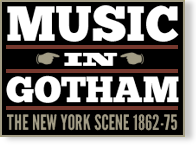Philharmonic Society of New York Rehearsal: 3rd for the 3rd concert
Event Information
Venue(s):
Academy of Music
Conductor(s):
Carl Bergmann
Event Type:
Orchestral
Record Information
Status:
Published
Last Updated:
14 August 2021
Performance Date(s) and Time(s)
04 Feb 1870, 2:30 PMPerformers and/or Works Performed
Citations
“The last rehearsal, previous to the third concert of the Philharmonic Society, was attended by an audience that not only filled every seat, but also every standing place, from the amphi-theatre to the pit. Two years ago the Society started with 150 subscribers, and now the sign ‘Standing Room Only’ is hung up almost as soon as the doors are opened. Yesterday the expectation of Prince Arthur’s presence certainly served as part of the bait that attracted so large an assemblage. As Prince Arthur, accompanied by Mr. and Mrs. Thornton, Professor Doremus and one or two other persons, entered Professor Doremus’ box, over which the English and American flags were draped, the orchestra struck up ‘God Save the Queen,’ the last movement in the overture to ‘Jubel,’ and the Prince bowed his acknowledgements. The regular programme for the concert was then interpreted. Spohr’s characteristic symphony in F, always a favorite in the concert room, and called ‘The Consecration of Sounds,’ after a poem by Carl Pfeiffer, went smoothly and well. This symphony possesses four distinct themes. The first theme: Largo—Gloomy silence of nature before the creation of sound; allegro—busy life afterwards, the elements; second theme—cradle song, dance, serenade; third theme—the march to battle, return of the victors, thanks to God; fourth theme—consolation amid tears, invocation of sounds. The second and third themes are especially beautiful. Miss Kellogg sang twice. The first time ‘Di piacer mi Balza il Cor,’ from Rossini’s ‘La Gazza Ladra,’ and the second time ‘Deh vieni non tu dar,’ from the ‘Nozze di Figaro,’ by Mozart. Miss Anna Mehlig, the distinguished pianist, played Beethoven’s concerto in E-flat major for piano and orchestra. Goldmark’s overture to ‘Sacuntela,’ has improved greatly on acquaintance, while Beethoven’s overture to ‘Leonora,’ No. 2, does not impress us as favorably as many of the other works of this great master; that wonderful vitality which perfected instrumental music as the language of feeling and the sentiments, seems wanting here. The concert occurs tonight.”

